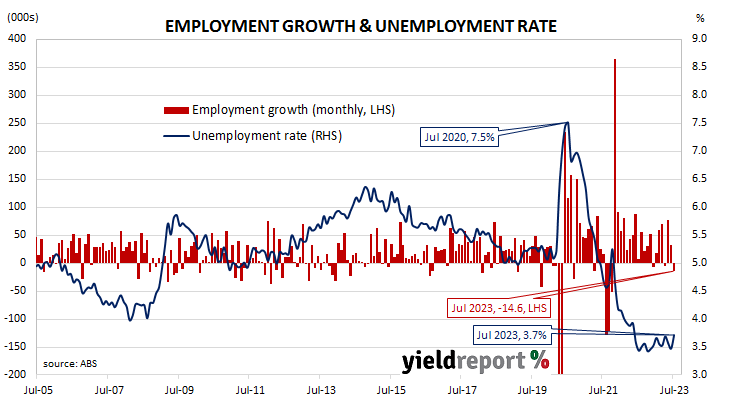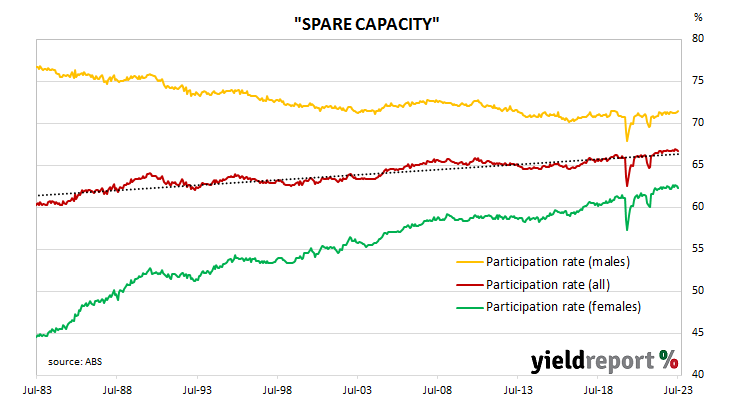Summary: Employment down 14,600 in July, contrasts with expected rise; ANZ: labour market may be at turning point; Citi: still consistent with economy operating in excess of full-employment; participation rate slips to 66.7%; jobless rate rises to 3.7%; more part-time, fewer full-time jobs; aggregate work hours up 0.2%; underemployment rate steady at 6.4%.
Australia’s period of falling unemployment came to an end in early 2019 when the jobless rate hit a low of 4.9%. It then averaged around 5.2% through to March 2020, bouncing around in a range from 5.1% to 5.3%. Leading indicators such as ANZ-Indeed’s Job Ads survey and NAB’s capacity utilisation estimate suggested the unemployment rate would rise in the June 2020 quarter and it did so, sharply. The jobless rate peaked in July 2020 but fell below 7% a month later and then trended lower through 2021 and 2022.
The latest Labour force figures have now been released and they indicate the number of people employed in Australia according to ABS definitions decreased by 14,600 in July. The result contrasted with the 15,000 increase which had been generally expected and June’s 31,600 rise after revisions.
“While weaker than we expected, the softness in the data fits neatly with the sentiment expressed in the RBA’s most recent set of minutes, which noted twice that the labour market might be at a turning point,” said ANZ Head of Australian Economics Adam Boyton. However, he also pointed to recent months’ volatility and noted “the unemployment rate printed at 3.7% in January and April, only to fall back again in subsequent months.”
Domestic Treasury bond yields increased noticeably on the day despite the figures. By the close of business, the 3-year ACGB yield had gained 6bps to 3.97%, the 10-year yield had added 11bps to 4.32% while the 20-year yield finished 10bps higher at 4.62%.
In the cash futures market, expectations regarding further rate rises firmed. At the end of the day, contracts implied the cash rate would barely change from the current rate of 4.07% and average 4.075% in September and 4.105% in October. February 2024 contracts implied a 4.215% average cash rate while May 2024 contracts implied 4.24%, 17bps more than the current rate.
“The 0.2 percentage point uptick in the unemployment rate to 3.7% in July contained in the Labour Force Survey is still consistent with an economy operating in excess of full-employment,” said Citi economist Josh Williamson. “However, the data was still a weak surprise to the market but arguably affected by post-pandemic holiday trends that led to lower labour force participation and weaker hiring.”
The participation rate slipped from June’s figure of 66.8% to 66.7% as the total available workforce increased by 21,000 to 14.567 million while the number of unemployed persons increased by 35,600 to 541,000. As a result, the unemployment rate increased from 3.5% to 3.7%.
The aggregate number of hours worked across the Australian economy increased by 0.2% even as 9,600 residents gained part-time positions and 24,200 residents lost full-time positions. On a 12-month basis and after revisions, aggregate hours worked increased by 5.2% as 30,500 more people held part-time positions and 378,900 more people held full-time positions than in July 2022.
More attention has been paid to the underemployment rate in recent years, which is the number of people in work but who wish to work more hours than they do currently. July’s underemployment rate remained unchanged at 6.4%, 0.6 percentage points above this cycle’s low.
The underutilisation rate, that is the sum of the underemployment rate and the unemployment rate, has a strong correlation with the annual growth rate of the ABS private sector wage index when advanced by two quarters. July’s underutilisation rate of 10.1% corresponds with an annual growth rate of about 4.1%.




